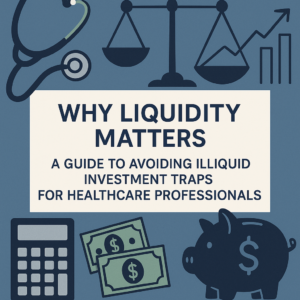The landscape of financial planning is continually evolving. The SECURE 2.0 Act, recently signed into law, introduces a unique opportunity that allows the rollover of excess dollars in a 529 college savings plan into a Roth IRA. This new provision offers young healthcare workers—including physicians, dentists, pharmacists, physical therapists, and psychologists—a strategic way to plan for long-term retirement savings.
Originally, 529 plans were designed to help families save for education expenses with tax advantages, encouraging long-term investment in education. Roth IRAs, on the other hand, were created to let people save with post-tax income, allowing tax-free withdrawals in retirement. The SECURE 2.0 Act includes other changes like increasing the required minimum distribution age and expanding catch-up contributions, reflecting Congress’s effort to help individuals save more effectively.
This blog post will explore the mechanics of the 529-to-Roth IRA rollover, discuss financial implications and benefits, highlight key considerations and potential pitfalls, and offer a forward-looking perspective on incorporating this strategy into a comprehensive financial plan.
Understanding the 529-to-Roth IRA Rollover
The 529-to-Roth IRA rollover opens new doors for long-term retirement goals. Here’s how it works and who is eligible:
Eligibility Criteria:
- Age of the 529 Plan: To qualify, the 529 plan must have been open for at least 15 years.
- Recent Contributions: Contributions made within the past five years and their earnings are not eligible for rollover. So, if you made a significant contribution three years ago, those funds must wait two more years. (Use “First In First Out” when applying this rule.)
Mechanics of the Rollover:
- Direct Transfer: Funds from the 529 plan are directly rolled over into a Roth IRA. This transfer must follow Roth IRA contribution limits and rules.
- Limits: There is a lifetime rollover limit of $35,000 per 529 plan beneficiary. Annual Roth IRA contribution limits (currently $7,000 or $8,000 for those aged 50 or above) also apply.
Congress introduced this provision to address the issue of leftover funds in 529 plans. By allowing these funds to roll over into a Roth IRA, families can reallocate their savings for long-term financial security. This policy could be a sign of future legislation aimed at increasing the flexibility of savings plans.
Financial Implications and Strategic Benefits
The 529-to-Roth IRA rollover can benefit young healthcare professionals in several ways:
Tax Advantages:
- Tax-Free Growth: Both 529 plans and Roth IRAs offer tax-free growth. Funds in a 529 plan grow tax-free, and Roth IRA withdrawals are also tax-free under certain conditions.
- Choice of Investments: Roth IRAs offer a broader range of investment choices compared to 529 plans, allowing for diversified and potentially higher returns over the long term.
Scenario-Specific Benefits:
- Parents with Excess 529 Funds: These parents can now redirect savings into their children’s retirement funds.
- As a Backup Plan: Young healthcare workers who considered using 529 funds for further education but changed their minds can use this rollover for retirement.
Key Considerations and Potential Pitfalls
While the 529-to-Roth IRA rollover has many benefits, there are important factors and potential pitfalls to consider:
Lifetime Rollover Limits and Contribution Caps:
- Lifetime Limit: The total lifetime rollover limit is $35,000 per beneficiary. This requires careful planning to make the most of the benefit.
- Annual Contribution Limits: Rollovers must align with annual Roth IRA contribution limits. It’s essential to plan rollovers according to these limits.
- Income Requirement: The beneficiary must meet the Roth IRA contribution rules, including the income requirement.
- Roth IRA Contribution Replacement: The rollover from 529 to Roth IRA in any given year replaces the Roth IRA contribution for that year.
- Gifting and Ownership: A contribution to a child’s 529 plan is a completed gift, and the ownership is the child’s. Therefore, the transfer would be into a child’s Roth IRA, when eligible. Transferring ownership (beneficiary election) to another, or back to the parent, may invoke alternate rules with tax implications.
The 529-to-Roth IRA rollover provision introduced by the SECURE 2.0 Act offers young healthcare workers a way to redirect their educational savings toward retirement effectively. This innovative approach helps in tax diversification, long-term financial security, and maximizing tax-free growth.
Given the intricate rules and eligibility criteria, meticulous planning and professional guidance are essential. By incorporating this option into a comprehensive financial strategy, healthcare professionals can optimize their savings, ensuring a secure and prosperous future.
Disclaimer: This content is for informational purposes only and does not constitute financial, legal, or tax advice. Consult a financial advisor to understand how these strategies may apply to your specific financial situation. The information provided is accurate at the time of writing, but laws and regulations may change. Always verify details and stay informed.






